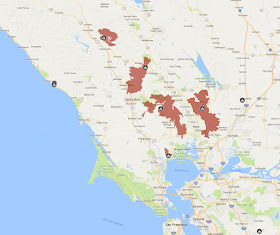I found the trip both scary and highly informative.
As many of you remember, the Wine Country fires occurred on October 8-9, 2017, with most of the damage associated with four major fires (see map below) north of San Francisco.
44 people died, thousands of homes were destroyed, and insured damage was around 10 billion dollars. Total loss was probably 50-100 billion.
The wine industry only experienced minor losses and our travels through much of the fire territory showed lush fields of grapes and crowded wineries and support businesses.
But then we entered the fire zones, where there were a lot of surprises. One surprise was that the trees were really not consumed, but blackened. There would be yellow/dead leaves but many of the trees were still alive, with some green leaves at the top. A thick growth of grass had clearly grown during the spring, and small plants/bushes were evident.
In some places flowers were coming up, even among the charred trees.
Clearly, the chaparral vegetation is highly robust to fire and was coming back quickly. I bet that in five years it will be hard to tell that the fires even occurred.
But then we entered some of the burned out neighborhoods of Santa Rosa, and the scene was apocalyptic and disturbing. Hundreds of burned out lots, with nearly all the fire debris removed. The remains of swimming pools and brick patios, but no houses to go with them. Desolation as far as the eye could see. I really felt bad for the people that lived there before--it was like a war zone.
Such neighborhoods are an example of the wildland/urban interface that might not be appropriate for building. But if you are going to live there, you need to have a house and surrounding designed to handle such fires. We did see some new houses going up, and they looked like traditional construction. Not good.
We also hiked above Berkeley, California in the hills that have produced huge, destructive fires, like the Tunnel Fire of 1991. Terribly overgrown with non-native and flammable Eucalypus trees and dry grass everywhere (see picture). There will be more fires there someday.
 |
| Above University of California, Berkeley |
My take away from all this is that the chaparral vegetation of the region appears highly robust to fires, and that there is a huge population living too close to fire-prone hills. My research deals with predicting the winds that produce the big fires of the region...that could help save lives, but too many folks are living in locations that have burned for millennia and will burn again--even under the "old normal."







So there's a simple solution for those living in the chaparrel country: Change the codes to require fire-resistant construction (Governor Brown, are you listening?)
ReplyDeleteAnd like the "herd effect" in epidemiology, if most of the houses in a neighborhood are fireproof, the remaining ones have a better chance.
The fire codes for building are good in Calif currently, for example fibercement siding rather than wood panel.
ReplyDeleteThe problem is a hundred years worth of building stock to gradually renovate/replace, and most people without the resources to do it.
I'm wondering what insurance company would sell fire insurance to cover "traditional " construction in those areas...and what lender would sell a mortgage to a homeowner who can't get/afford it. If I were a loan officer, it would be a cold day in hell before i approved a mortgage to rebuild a prefab weenie roast in an interface area.
ReplyDeleteBuilding in these types of areas ( fire zones, flood prone areas etc)should always be uninsurable unless certain criteria are met. If local building codes won't protect people from being stupid, than maybe free markets can. Stupidity should be monetarily expensive. Never mind the fact that it could also be fatal.
ReplyDeleteTaxpayers stepping in where insurance companies won't in the rebuilding process should also skip the emotional (rebuild just how it was) routine and actually offer to either relocate or demand rebuilding that conforms to the challenges of the area. IE, build on columns in flood prone areas or use of fire resistant materials. Even if it means the end result is smaller or not as fancy as what was destroyed. Replacing wrong with more wrong is just dumb. Unfortunately, its the American way.....
How about removing the non native Eucalyptus. Those leaves contain oils and burn for a long time. A large smoke column or wind will keep them aloft and create spot fires all over when they land. Spot fires can be real killers to suppression forces.
ReplyDeleteThanks for your persona eye witness report, Cliff. Good fodder for your upcoming wildfire explorations and offerings.
ReplyDeleteCalifornia real estate turns over more slowly than in most places because Prop. 13 keeps property taxes the same until the property is sold, regardless of appreciation in the meantime. So many of those old-construction homes may be paid off and uninsured, or insured with old insurance policies that allowed them to be covered.
ReplyDeleteYes, I would hope that they are rebuilt with current best practices, not with wood.
Is the Diablo Fires paper published somewhere? It would be a good read!
ReplyDeleteWondering if East Coast hurricanes have any effect on our weather. Butterfly wings theory etc.
ReplyDelete